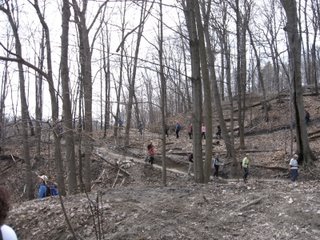If you answered yes to either of these questions you'd be wrong. The most interesting project is the reconfiguration of the railway bridge just north of Lakeshore. Officially known as the "Kingston Overpass", this bridge has caused many problems for the Don River. Not to say that it has been the instigator, rather it has been against this intractable obstacle that problems with the river have been revealed.
It all started about 50 years ago when Hurricane Hazel roared through Toronto in its history making path of destruction. While the main loss of life was in the Humber River valley, Hazel dumped record amounts of rainfall in the Don River watershed. All this water rushed down the valley. Whereas water in the Humber emptied unimpeded into Lake Ontario, the Don flood came up against the railway underpass. The flow of water was over 400 times the daily flow so there was not enough space for all that water to flow underneath the bridge. The water had to go somewhere and it overflowed the banks as far east as Leslie Street and as far west as Bay Street.
Since then the impact of the flood has set the benchmark for all future development. The main reason why the West Don Lands has remained derelict is mainly because the Toronto Region Conservation Authority has a veto over any development. They insist that any new building be floodproofed against a reoccurrence of Hurricane Hazel, something that a majority of builders find too expensive. The naturalization of the mouth of the Don has also been delayed because no one knew how much water would flow south if the bridge were ever reconfigured.
Then along came the Waterfront Revitalization Task Force and they made the mouth of the Don and the West Don Lands redevelopment two of their priorities. In order to accomplish this, they had to fix the flooding problem. Much to everyone's surprise this is now well underway.
Basically, the idea is simple - in order to eliminate the flooding north of the bridge all you need to do is give the river more space to flow underneath the bridge. A simple idea but a complex implementation. Not only do you have to increase the span length you also have to do it while the bridge is still in use. The bridge contains four separate tracks that carry Go trains and other trains every day.

New construction creates two new underpasses
The construction procedure has been straightforward but meticulously slow. They divided the bridge into two sections. The northern half of the bridge (two tracks) were closed down and torn up. They excavated a new underpass on the west side of the river and built a new span over top. Concrete was poured and new track was laid. This process was also complicated by the fact that the space where they were excavating is also occupied by a high power electrical conduit. This had to be relocated as well. To date the northern half is finished and they are now working on the southern half.

Boring new pilings. Construction continues while a Go Train passes by.

Pouring the foundation for the Kingston underpass.

Tight deadlines necessitated work at all hours. Here a girder is installed on the Kingston span.

Pre-poured railbeds installed on top of new span.

Installing the new track.
A second smaller tunnel is also being created underneath the Don corridor that will eventually connect the trail to the new Don River Park and the West Don Lands.

The new tunnel to connect to the Don River Park.

Excavation the tunnel. The round posts on the right are the original pilings from when the railway was first constructed.

Top view of construction on Bala underpass
For anyone wanting a more detailed report, please view the Lower Don River West News on the project.
The path is scheduled to be reopened in May. When this happens we will have a new at grade pedestrian tunnel (no more dipping down then up again). Even more so, we will finally have a river whose flow is encumbered by one less manmade obstacle.
Note: Normally I would take my own photographs but due to construction site rules visitors are not permitted onsite. My thanks go to Ken Dion, TRCA project manager and Tony Angelo at Totten Sims Hubicki on behalf of TRCA and TWRC for providing these pictures.















































